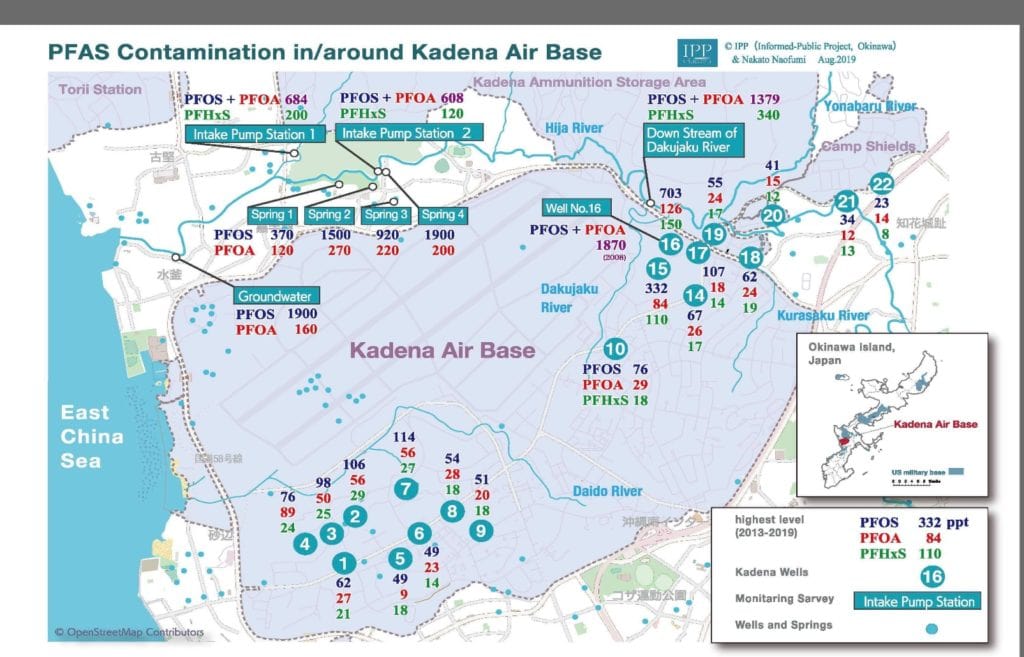In 1945, the Truman administration knew that the Japanese government was trying to negotiate surrender through Moscow. The U.S. completely dominated Japan militarily by August of 1945 when it destroyed Hiroshima and Nagasaki with two bombs, thereby ending the lives of hundreds of thousands of civilians and ruining the lives of millions.
Why bring it up now? Because 74 years later the Japanese are still trying to surrender, while the U.S. government continues to wage war.

It has been three years since we heard the news from the Okinawa Prefectural Government that the rivers and the groundwater around the U.S. military’s Kadena Air Base were polluted with deadly PFAS chemicals. We knew then that this water is used to replenish municipal wells, and we knew that human health was endangered on a massive scale.
Yet nothing has changed. Most people, even Okinawans, are still unaware of the contaminated water and most of those who are aware, or are in positions of authority, seem unwilling to stand up for the 450,000 Okinawan residents whose health is on the line.
Despite knowing that the Island of Okinawa is being poisoned by their American overlords with the cooperation of the client state of Japan that dominates them, official Okinawa’s reaction leaves much to be desired. They have displayed resignation rather than indignation. Is this lack of commitment to the rights of Okinawans not the result of being under the yoke of the U.S. empire for 74 years?
The detailed map from the Informed-Public Project above, shows PFOS/PFOA contamination in ground water along the Hija River adjacent to Kadena Air Base reaching 2,060 parts per trillion (ppt), i.e., PFOS 1900 plus PFOA 160. Nearby, spring water was found to contain 2,100 ppt of the carcinogens. (See Spring 4). That is before the water is treated and sent through pipelines to consumers. After treatment, the average PFOS/PFOA levels in the “clean” water of the (nearby) Chatan water purification plant is about 30 ppt, according to the island’s water board, the Okinawa Prefecture Enterprise Bureau.
Okinawan water authorities point to the EPA’s Lifetime Health Advisory of 70 ppt for the substances and conclude that the water is safe. Scientists with the Environmental Working Group, however, say levels in drinking water should not exceed 1 ppt, while several states have set limits that are a fraction of Okinawa’s levels. PFAS chemicals are deadly and extraordinarily persistent. They cause a host of cancers, wreak havoc on a woman’s reproductive health, and damage the developing fetus.

Toshiaki TAIRA, the head of the Okinawa Prefectural Enterprise Bureau, says he thinks that with such concentrations of PFAS in rivers in the vicinity of Kadena Airbase, the prime suspect is Kadena Air Base.
Meanwhile, Ryūkyū Shimpō, one of the more reliable newspapers that reports on Okinawa, cites a study by two Japanese scientists that clearly identifies Kadena Air Base and Futenma Air Station as the sources of the contamination.
Asked by Washington Post reporters about the charges of PFAS contamination,
Air Force Col. John Hutcheson, spokesman for U.S. Forces Japan, repeated three talking points used in more than a hundred similar cases of PFAS contamination around the world:
- The chemicals had been used for fighting petroleum fires primarily at military and civilian airfields.
- S. military installations in Japan are transitioning to an alternative formula of aqueous film-forming foam that is PFOS free, that only contains trace amounts of PFOA and meets military specifications for firefighting.
- Hutcheson declined to comment on the toxic contamination outside the base. He said, “We have seen press reports but have not had a chance to review the Kyoto University study, so it would be inappropriate to comment on its findings,” Hutcheson said.
Outside the DOD spin room of alternative facts, dangerous chemicals are still being used in the fire-fighting foams with devastating health impacts. The carcinogens are now leaching into groundwater and surface water even while the military says it is studying the situation. The EPA is studying the situation, too. This is how they manage to kick the can down the road. This approach seems to work well with the complacent Japanese government.
Junji SHIKIYA, a manager of the Okinawan water supply, has said that he suspects that some synthetic fluorinated chemicals could have been used at the Kadena Air Base.
That’s all the fire they can muster? They suspect the carcinogens could have been used at the base, so…?
While the U.S. government pollutes their water, the taxpayers of Okinawa are paying for costly charcoal filter systems that must be periodically replaced. In 2016 the Okinawa Prefectural Enterprise Bureau had to spend 170 million yen ($1.5 million) to replace the filters that they use to treat the water. The filters use “granular activated carbon,” which are like tiny pebbles that absorb contaminants. Even with the upgrade, water is still being supplied to the public laden with the toxins. Because of the additional costs, the Prefectural Government has asked the central government to compensate them.
The story is similar to the costs borne by the town of Wittlich-Land, Germany to incinerate sewer sludge contaminated with PFAS from the U.S. Spangdahlem Airbase. The town was ordered by the federal government of Germany not to spread the highly contaminated sludge on farm fields, forcing the community to incinerate the materials. Wittlich-Land discovered it was not allowed to sue the U.S. military to recover the costs of incineration, so it is suing the German government. The case is pending.
Neither the government of Japan nor the local government in Okinawa can sue the U.S. government either. And their current posture hardly inspires confidence in their commitment to the health of Okinawans.
In Okinawa, the authorities seem to be avoiding any challenge to the imperial order. Toshinori TANAKA, head of the Okinawa Defense Bureau, laid down the law in refusing to pay for damages caused by the contamination. “No causal relationship between the detection of PFOS and the presence of the U.S. military has been confirmed. In addition, the standard to regulate the maximum level for PFOS has not been set for tap water in Japan. Therefore, under this circumstance, we cannot conclude that the compensation should be granted.”
Subservience and obedience hold empires together while most people suffer.
To their credit, the Okinawa Prefectural Enterprise Bureau did request an on-site inspection of the bases, but they were denied access by the Americans.
Of course. The same is true everywhere.
Okinawa International University Professor Hiromori MAEDOMARI explains the problem from the perspective of Japanese citizens, including Okinawans, who have the right to know what is going on. This pollution of land is occurring within Japan’s territory, so the Japanese government should be able to exercise their authority as a sovereign state, but he says that discussions between the governments of the U.S. and Japan about the PFOS issue are shrouded in darkness, as if they are inside a kind of “black box,” where the internal workings cannot be seen by citizens peering in from the outside. He emphasizes the need for citizens to pay attention to this issue. (His interview is available here.)
The states of New Mexico and Michigan are suing the U.S. federal government for PFAS contamination, but the Trump administration is claiming the military enjoys sovereign immunity from attempts by states to prosecute, so the military is free to continue poisoning people and the environment.
In Japan the situation is even worse. This is because citizens there cannot gain basic knowledge of the inner workings of the “black box” of Japan-U.S. negotiations to clarify responsibility. Is the Japanese government short-changing Okinawans? What kind of pressure is Washington putting on Tokyo to disregard the rights of Okinawans? Americans, Japanese, and Okinawans must stand up and demand some basic accountability from their governments. And we must demand that the U.S. military clean up their mess and compensate Okinawans for the damage to their water supply.
Click to Subscribe to the Civilian Exposure Newsletter for Latest News & Updates Today!

